Species Description: Sambirano Woolly Lemur
Common Name: Sambirano Woolly Lemur
Scientific Name: Avahi unicolor
Habitat
Geographic and Environmental Context: The Sambirano Woolly Lemur is primarily found in the lush rainforest regions of Madagascar, particularly within the Sambirano area. This species thrives in humid, dense forest habitats characterized by tall trees, rich biodiversity, and a warm climate. Its presence is often closely associated with the unique flowering plants and trees of this endemic habitat.
Physical Characteristics
Size, Color, and Distinct Features: The Sambirano Woolly Lemur is a medium-sized primate, averaging about 1.8 feet in length. Its fur is distinctly soft and dense, typically exhibiting a rich gray or brown hue with lighter underbelly coloration. Unique features include large, expressive eyes that facilitate low-light vision, and a robust tail that can be as long as its body, aiding in balance during arboreal locomotion.
Behavior
Typical Behaviors: This species is primarily nocturnal, engaging in activity during the night to forage for food. Sambirano Woolly Lemurs are known to be arboreal, spending most of their time in the trees. Their social structure tends to be matriarchal, with females leading the groups. They communicate through a range of vocalizations, and grooming is a significant social behavior that reinforces bonds within groups.
Diet
Feeding Habits: The diet of the Sambirano Woolly Lemur primarily comprises fruits, leaves, and flowers, with a particular preference for ripe fruits and young leaves abundant in their rainforest habitat. This dietary flexibility allows them to adapt to seasonal changes in food availability, vital for their survival in Madagascar’s fluctuating climate.
Reproduction
Breeding Habits: The Sambirano Woolly Lemur typically breeds once annually, with the mating season occurring around mid-year. After a gestation period of approximately five months, usually one offspring is born. The young are cared for by the mother exclusively, and they cling to their mother’s belly for several weeks before gaining independence.
Conservation Status
Status and Threats: The Sambirano Woolly Lemur is currently listed as ‘Endangered’ on the IUCN Red List, primarily due to habitat loss from deforestation, illegal logging, and agricultural expansion within Madagascar. Conservation efforts are crucial to protect their remaining habitats and ensure the species’ survival.
Interesting Facts
Unique Traits and Trivia: One fascinating aspect of the Sambirano Woolly Lemur is its ability to leap over 15 feet between trees, showcasing remarkable agility. Additionally, they have a unique vocalization pattern that varies between different groups, suggesting a high level of communication sophistication.
Role in Ecosystem
Ecological Importance: The Sambirano Woolly Lemur plays a vital role in its ecosystem as a seed disperser, contributing to forest regeneration and biodiversity. By feeding on various fruits and flowers, they facilitate the growth of new plants, thus supporting a balanced and thriving rainforest environment.
